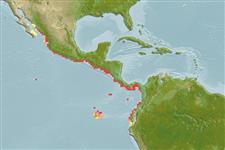Common names from other countries
Environment: milieu / climate zone / depth range / distribution range
Écologie
; saumâtre; profondeur 0 - 20 m (Ref. 109200), usually 0 - 15 m (Ref. 80605). Subtropical; 26°C - 38°C (Ref. 68684); 27°N - 4°S, 114°W - 77°W (Ref. 109211)
Eastern Pacific: From Laguna Ballena, Baja California Sur, Mexico to Bahía de Tumbes, Peru.
Length at first maturity / Taille / Poids / Âge
Maturity: Lm ? range ? - ? cm
Found in salinities from 30-40 ppt in Baja California Sur, Mexico (Ref. 68684). Occurs in mangrove estuaries (Ref. 80605). Lives mainly in or near the red mangrove Rhizophora mangle (Ref. 109200) as well among the roots of Avicennia germinans and Laguncularia racemosa (Ref. 121717). Individuals are found at about 15 cm deep in level muddy bottom among the prop roots of Rhizophora spp. (Ref. 80605), in intertidal mud flats between mangrove trees and the low tide line (Ref. 109200).
Life cycle and mating behavior
Maturité | Reproduction | Frai | Œufs | Fécondité | Larves
Members of the class Bivalvia are mostly gonochoric, some are protandric hermaphrodites. Life cycle: Embryos develop into free-swimming trocophore larvae, succeeded by the bivalve veliger, resembling a miniature clam.
Turgeon, D.D., J.F. Quinn Jr., A.E. Bogan, E.V. Coan, F.G. Hochberg, W.G. Lyons, P.M. Mikkelsen, R.J. Neves, C.F.E. Roper, G. Rosenberg, B. Roth, A. Scheltema, F.G. Thompson, M. Vecchione and J.D. Willams. 1998. (Ref. 1667)
Statut dans la liste rouge de l'IUCN (Ref. 130435)
statut CITES (Ref. 108899)
Not Evaluated
Not Evaluated
Utilisations par l'homme
Pêcheries: commercial
| FishSource |
Outils
Plus d'informations
Taille/ÂgeCroissanceLongueur-poidsLongueur-longueurMorphologieLarvesAbondance
Sources Internet
Estimates based on models
Preferred temperature
(Ref.
115969): 24.3 - 29.1, mean 27.5 (based on 139 cells).
Résilience
Haut, temps minimum de doublement de population inférieur à 15 mois (K=0.09-1.85).
